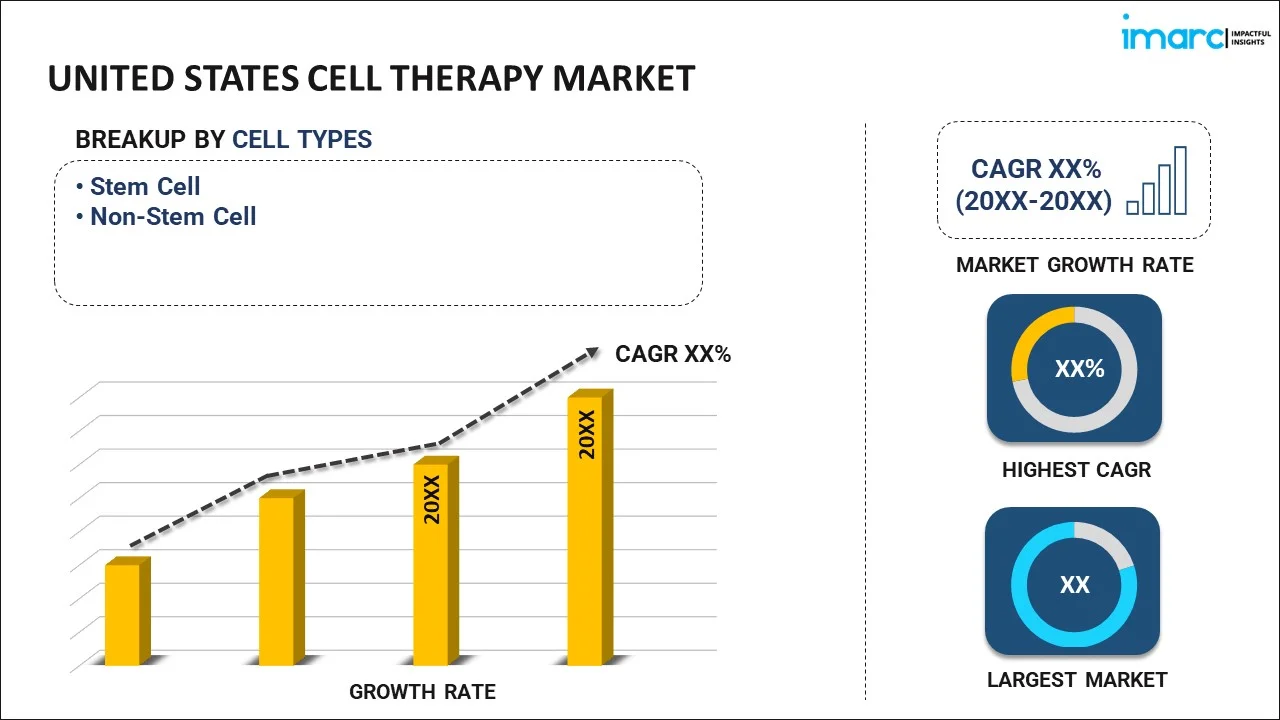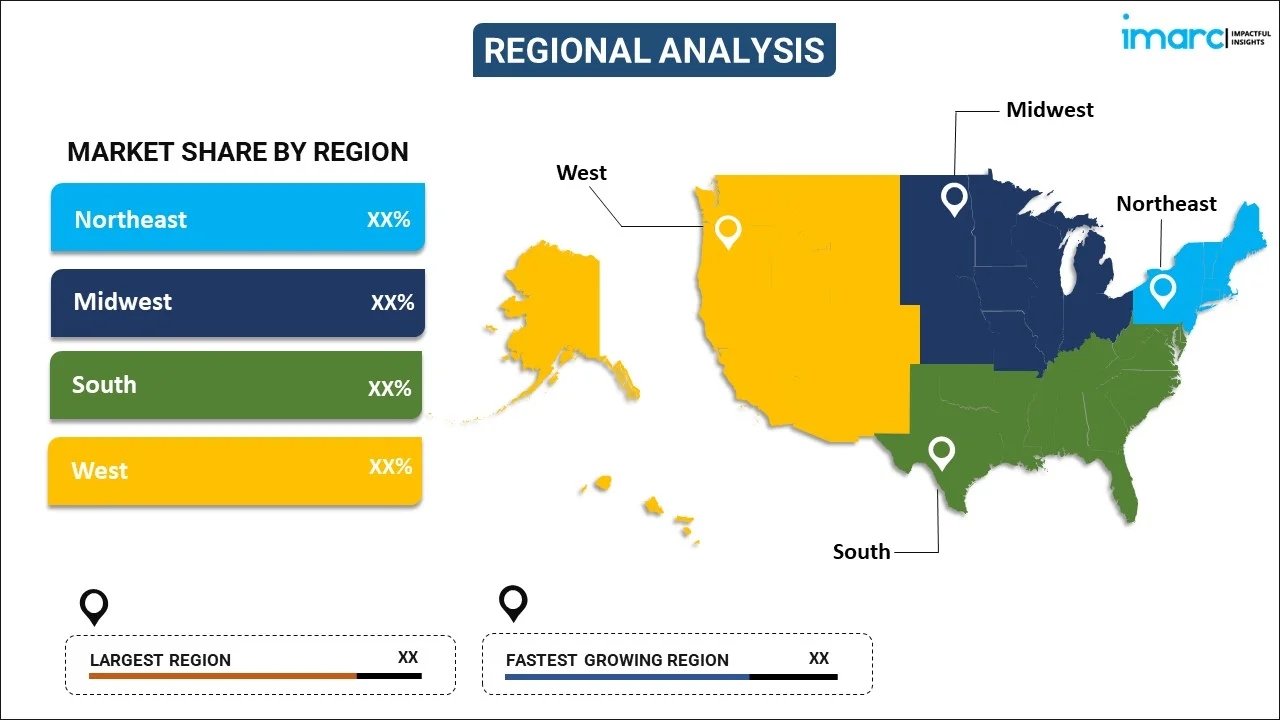
United States Cell Therapy Market Report by Cell Type (Stem Cell, Non-Stem Cell), Therapy Type (Autologous, Allogeneic), Therapeutic Area (Malignancies, Musculoskeletal Disorders, Autoimmune Disorders, Dermatology, and Others), End User (Hospitals and Clinics, Academic and Research Institutes), and Region 2024-2032
Market Overview:
The United States cell therapy market size is projected to exhibit a growth rate (CAGR) of 11.60% during 2024-2032. The rising number of chronic ailments, such as cancer, diabetes, and cardiovascular diseases, the increasing investment in cell therapy research and development (R&D) in private and public sectors, and several advancements in biotechnology are essential in the expansion of cell therapy, represent some of the key factors driving the market.
|
Report Attribute
|
Key Statistics
|
|---|---|
|
Base Year
|
2023 |
|
Forecast Years
|
2024-2032
|
|
Historical Years
|
2018-2023
|
| Market Growth Rate (2024-2032) | 11.60% |
Cell therapy is an innovative medical approach that harnesses the power of living cells to treat various diseases and conditions. It involves the transplantation or manipulation of living cells to restore, improve, or replace damaged or dysfunctional tissues within the body. These cells can come from various sources, including the patient themselves (autologous), donors (allogeneic), or even engineered cells. It promotes healing and regeneration by using the unique abilities of several cell types. Stem cells are undifferentiated cells that have the remarkable capability to develop into various cell types within the body, which makes them invaluable in treating conditions including degenerative diseases, injuries, and autoimmune disorders. Stem cell therapy has shown promise in the treatment of conditions such as Parkinson's disease, spinal cord injuries, and certain types of cancer. Additionally, immunotherapy focuses on harnessing the body's immune system to combat diseases, including cancer, while chimeric antigen receptor t-cell (CAR-T) therapy is a type of immunotherapy that involves modifying a patient's T-cells to target and destroy cancer cells. It demonstrated remarkable success in treating certain forms of leukemia and lymphoma. It includes several approaches and applications. For instance, it can be used to repair damaged heart tissue after a heart attack, restore vision in individuals with retinal degeneration, and even address genetic disorders at the cellular level.
United States Cell Therapy Market Trends:
The market is primarily driven by the rising number of chronic ailments, such as cancer, diabetes, and cardiovascular diseases. Cell therapies offer promising treatment options, often with fewer side effects compared to traditional treatments, making them an attractive choice for both patients and healthcare providers. In addition, the increasing investment in cell therapy research and development (R&D) in private and public sectors due to the potential of cell therapies led to increased funding and investments, which allowed companies to conduct rigorous clinical trials, further validating the efficacy of these treatments, thus contributing to the market growth. Moreover, several advancements in biotechnology are essential in the expansion of cell therapy, allowing researchers and biotech companies to make significant progress in understanding the mechanisms of cell-based treatments, leading to the development of more effective therapies which enhances the confidence in the safety and efficacy of cell therapies, representing another major growth-inducing factor. Along with this, the implementation of policies to facilitate the development and approval of cell-based products streamlined the regulatory process, which encouraged investment in research and development (R&D), making it easier for companies to bring innovative therapies to market, thus propelling market growth. Apart from this, the growing geriatric population is escalating the demand for advanced medical treatments, such as cell therapies, which address age-related conditions such as osteoarthritis and neurodegenerative diseases, thus augmenting the market growth.
United States Cell Therapy Market Segmentation:
IMARC Group provides an analysis of the key trends in each segment of the market, along with forecasts at the country level for 2024-2032. Our report has categorized the market based on cell type, therapy type, therapeutic area, and end user.
Cell Type Insights:

- Stem Cell
- Bone Marrow
- Blood
- Umbilical Cord-Derived
- Adipose-Derived Stem Cell
- Others
- Non-Stem Cell
The report has provided a detailed breakup and analysis of the market based on the cell type. This includes stem cell (bone marrow, blood, umbilical cord-derived, adipose-derived stem cell, and others) and non-stem cell.
Therapy Type Insights:
- Autologous
- Allogeneic
A detailed breakup and analysis of the market based on therapy type have also been provided in the report. This includes autologous and allogeneic.
Therapeutic Area Insights:
- Malignancies
- Musculoskeletal Disorders
- Autoimmune Disorders
- Dermatology
- Others
The report has provided a detailed breakup and analysis of the market based on the therapeutic area. This includes malignancies, musculoskeletal disorders, autoimmune disorders, dermatology, and others.
End User Insights:
- Hospitals and Clinics
- Academic and Research Institutes
A detailed breakup and analysis of the market based on end users have also been provided in the report. This includes hospitals and clinics and academic and research institutes.
Regional Insights:

- Northeast
- Midwest
- South
- West
The report has also provided a comprehensive analysis of all the major regional markets, which include the Northeast, Midwest, South, and West.
Competitive Landscape:
The market research report has also provided a comprehensive analysis of the competitive landscape in the market. Competitive analysis such as market structure, key player positioning, top winning strategies, competitive dashboard, and company evaluation quadrant has been covered in the report. Also, detailed profiles of all major companies have been provided.
United States Cell Therapy Market Report Coverage:
| Report Features | Details |
|---|---|
| Base Year of the Analysis | 2023 |
| Historical Period | 2018-2023 |
| Forecast Period | 2024-2032 |
| Units | US$ Million |
| Scope of the Report | Exploration of Historical and Forecast Trends, Industry Catalysts and Challenges, Segment-Wise Historical and Predictive Market Assessment:
|
| Cell Types Covered |
|
| Therapy Types Covered | Autologous, Allogeneic |
| Therapeutic Areas Covered | Malignancies, Musculoskeletal Disorders, Autoimmune Disorders, Dermatology, Others |
| End Users Covered | Hospitals and Clinics, Academic and Research Institutes |
| Regions Covered | Northeast, Midwest, South, West |
| Customization Scope | 10% Free Customization |
| Report Price and Purchase Option | Single User License: US$ 3699 Five User License: US$ 4699 Corporate License: US$ 5699 |
| Post-Sale Analyst Support | 10-12 Weeks |
| Delivery Format | PDF and Excel through Email (We can also provide the editable version of the report in PPT/Word format on special request) |
Key Questions Answered in This Report:
- How has the United States cell therapy market performed so far and how will it perform in the coming years?
- What has been the impact of COVID-19 on the United States cell therapy market?
- What is the breakup of the United States cell therapy market on the basis of cell type?
- What is the breakup of the United States cell therapy market on the basis of therapy type?
- What is the breakup of the United States cell therapy market on the basis of therapeutic area?
- What is the breakup of the United States cell therapy market on the basis of end user?
- What are the various stages in the value chain of the United States cell therapy market?
- What are the key driving factors and challenges in the United States cell therapy?
- What is the structure of the United States cell therapy market and who are the key players?
- What is the degree of competition in the United States cell therapy market?
Key Benefits for Stakeholders:
- IMARC’s industry report offers a comprehensive quantitative analysis of various market segments, historical and current market trends, market forecasts, and dynamics of the United States cell therapy market from 2018-2032.
- The research report provides the latest information on the market drivers, challenges, and opportunities in the United States cell therapy market.
- Porter's five forces analysis assist stakeholders in assessing the impact of new entrants, competitive rivalry, supplier power, buyer power, and the threat of substitution. It helps stakeholders to analyze the level of competition within the United States cell therapy industry and its attractiveness.
- A competitive landscape allows stakeholders to understand their competitive environment and provides an insight into the current positions of key players in the market.
Need more help?
- Speak to our experienced analysts for insights on the current market scenarios.
- Include additional segments and countries to customize the report as per your requirement.
- Gain an unparalleled competitive advantage in your domain by understanding how to utilize the report and positively impacting your operations and revenue.
- For further assistance, please connect with our analysts.
 Inquire Before Buying
Inquire Before Buying
 Speak to an Analyst
Speak to an Analyst
 Request Brochure
Request Brochure
 Request Customization
Request Customization




.webp)




.webp)












